Radio History by the Bay
[March 2014] This month marks the 92nd anniversary of the first intentional AM directional antenna in the US. About a decade ago, Ron Rackley “found” the site and tried to get permission for an historical marker to be placed there. We met him at the Clearwater, FL site to discuss how radio transmission techniques have changed over the years.
In March 1932 it was the location of a revolutionary advance in AM broadcasting. Now it is a slightly overgrown section of land next to a gas station/convenience store.
Today, directional Antennas are common in broadcasting. From the Yagi type antennas used for auxiliary services to the multi-tower arrays used to “shoehorn” AM stations into markets with ever increasing power, we use them for signal enhancement or signal reduction. Directional antennas permit operation where non-directional activity just would not accomplish the technical requirements.
At the same time, once installed, most directional antennas seem to be given little attention. They work so well, one consultant suggested we might soon run out of engineers who truly understand them.
Yet, in a true, “they said it couldn’t be done” story, the very first directional antenna used in broadcasting was almost not finished. Nay Sayers thought it was impossible to set up and run; it would be just a vain pursuit.
Dunedin Days
The story of AM directional antennas begins in 1925 with George W. Bowles, a real estate entrepreneur in Dunedin, Florida. As the West coast of Florida began to be developed, there was a need to get people to buy property and move down to retire in the sun.
Bowles somehow learned about Walter Tison, a ham operator who had been instrumental in providing the first transmitter for WSB in Atlanta.
Tison, no longer attached to WSB, was seeking to sell his transmitter to another potential broadcaster. So Bowles arranged to bring Tison and his 500-Watt transmitter to Dunedin, where it was installed on the roof of the Fenway hotel.
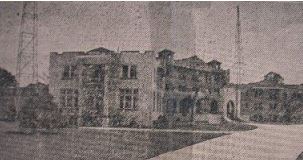
Fenway Hotel – 1926
Dunedin Times
Opening Night
Amid appropriate fanfare, WGHB went on the air on December 10, 1925.
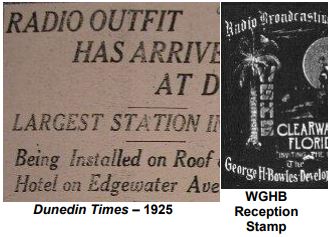
As with most early stations, at first the studio was on the roof along with the transmitter, accessible only via a long ladder. Just in time for the Grand Opening a studio was finished at ground level, so dignitaries would not have to climb the ladder.
The impact was immediate. During the inaugural broadcast, some 425 telegrams were reportedly received from 36 states and Canada.
After the Splash
Unfortunately, the real estate boom in Florida was having troubles, which in turn created cash flow problems for Bowles.
Forced to sell his interests in the Fenway and the radio station, the station was moved to Edward Haley’s Fort Harrison Hotel in Clearwater.
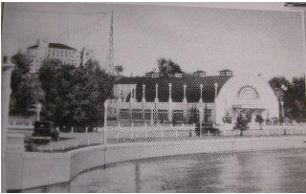
Fort Harrison Hotel – 1927
Re-Christened WFHH in early February 1927, the station essentially was operated by the Clearwater Chamber of Commerce.
Then, six months later, a station down in Boca Raton died and they got the call sign they really wanted: WFLA – “West Florida.”
WFLA did not operate alone for long. Although it had a good allocation on 850 kHz, in addition to the half dozen other area stations like WDAE, WFLA had to justify its continued existence to the Federal Radio Commission (FRC).
Since all stations were essentially non-directional at the time, only a limited number of stations could operate at night without excessive interference. That led to tremendous pressure on the FRC to eliminate those stations operating only part time, and replace them with facilities that promised to use the increasingly crowded dial to the full.
Dual Operation
The solution for WFLA was to sell a half-interest in the station to a neighboring Chamber of Commerce. The St. Petersburg Chamber of Commerce quickly agreed to pay $6,000 to share the transmitter.
Taking the calls WSUN (Why Stay Up North?) to lure visitors, the St. Petersburg station was permitted three days a week, and alternate Sundays for their operation on the new, and better frequency of 590 kHz.
From there, the sister stations, now WFLA-WSUN, were moved to 620 kHz with 2,500 Watts daytime and 1,000 Watts at night, beckoning northerners to enjoy the sun and warm Gulf waters.
Although there were few other stations on the 620 frequency, one of them was owned by the Milwaukee (WI) Journal. Seeking to increase its signal to 5,000 Watts, WTMJ asked the FRC to either abolish WFLA-WSUN, or cut its power. To further press it rights, WTMJ went to court; the US Court of Appeals directed the FRC to adjust WFLA-WSUN to protect WTMJ’s service area.
The FRC, an agency with limited control over the broadcast industry, responded by reducing WFLA-WSUN’s power to 500 Watts daytime and 250 Watts at night. That action essentially deprived them of the listeners they needed for both the success of the stations and their communities.
A Novel Idea
At that point, the future operation of WFLA-WSUN looked rather bleak.
Without access to listeners in the North, there was little value to the Chambers of Commerce in operating a radio station. They even considered turning in the license.
But Walter Tison was no one to give up. He approached the situation in two ways: First, he applied for a huge increase in power for the station, WTMJ’s court order notwithstanding. Then, he contacted Commander T.A.M. Craven, the consulting engineer for WFLA-WSUN, for assistance in designing and constructing a directional antenna.
While there had been experiments on directive receiving antennas, and some transmitting facilities, it was mainly for shortwave, point-to-point usage. Furthermore, some engineers derided the concept of using a directive antenna at AM frequencies, suggesting the real problem was the way the WFLA-WSUN signal went across the Gulf of Mexico and “turned” up the Mississippi River Valley, to reach Milwaukee.
Others simply said the ionosphere did not have a smooth surface, and the resulting propagation would not be as anticipated.
The First Directional Antenna
Craven, who would go on to serve as the first Lead Engineer at the FCC, and later an FCC Commissioner, decided Tison’s solution had potential for success. He then enlisted the aid of Ray Wilmotte, a British engineer.
Wilmotte had done quite a lot of study into the way directional antennas worked and concurred this was the right option for WFLA-WSUN.
In fact, Wilmotte was so sure of himself that he agreed to be paid only if he was successful. Together, Craven and Wilmotte undertook to construct the antenna. Calculations were carefully made regarding the groundwave and skywave toward Milwaukee.
The tower bases and guy anchors were laid along the Davis Causeway (later renamed the Courtney Campbell Causeway) in Clearwater in March 1932, and tests began in May of that year.
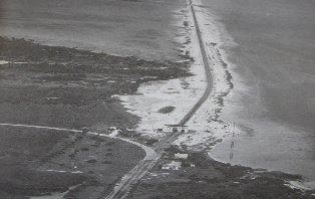
Davis Causeway – 1934
A 200-foot self-supporting tower was constructed on either side of the road, a quarter wavelength apart, in line with the bearing toward Milwaukee: 346 degrees.
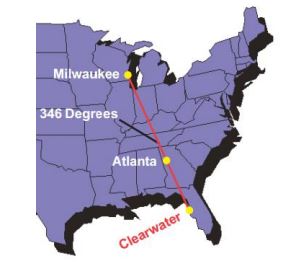
The RF circuit itself actually was quite simple, with the transmission lines cut to length and then routed in a “curved” way to the towers. One tower was coupled with a coil to shift the signal -45 degrees; the other was coupled with a condenser, to shift the signal +45 degrees. The phase angle between the two towers was 90 degrees.
The result was a tight cardioid pattern, with the minima at 346 degrees, toward Milwaukee.
Engineers were sent out in the field with such meters as existed then, as well as radios. However, even with such a simple array, the tune-up did not go as quickly or as easily as expected.
It soon became apparent to the constructors that they had not fully taken mutual impedance factors into account, as even the relatively primitive bridges available showed different antenna base impedances. Thus, much of the additional “tuning” was done by making adjustments until the signal “faded out” at the location of the monitoring engineers.
Wilmotte’s Success
In the end, it turned out Wilmotte was right in his calculations, and a satisfactorily deep minima was obtained.
The final cardioid pattern sent a strong signal to the north while reducing the signal toward Milwaukee well below required levels.
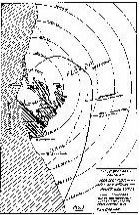
Craven’s drawing of WFLA-WSUN radiation pattern (1932)
In fact, the antenna worked so well that the FRC inspector in Atlanta, who was to measure the frequency of the station, instead had to ask if WFLA-WSUN had authority to be off the air.
He could not hear the station at all!
Indeed, the two-tower WFLA-WSUN directional antenna was a complete success. It operated for 18 years from the site on the causeway, accompanying the city’s entry gate as a sentinel marking the entrance to Clearwater.
Reliable Operation
Quite a few transmitter logs have been saved from the operation of the plant, and the stability of the first AM directional antenna still can be seen today.

Wilson Welch, with the original
WFLA-WSUN logs from 1934-1939
Of special interest is some of the terminology used in the logs. Engineers carefully noted the operating parameters, and special situations. Among the logs are notes related to repairs done, even the reduction in power used during the later stages of World War II.
Perhaps to describe the effect of the directional array in terms better understood in 1932, Tison referred to it often as a “shield” or “shielded transmission,” to indicate a “shield” kept the signal from going toward Milwaukee.

A portion of the WFLA-WSUN logs from 1935
Dutifully, the engineers noted each day when the array was “shielded” or “shield put on.” I did look at quite a few of the logs, but none of them said “shields up.” Apparently, no Starfleet officers worked at WFLA-WSUN.
MOVING DOWN THE BAY
The two stations continued to send joint “Southern Greetings” to folks up North for about eight years.
But the Clearwater Chamber of Commerce had had enough, and sold its half interest (WFLA) to the Tampa Tribune, which promptly changed the station’s “home” to Tampa. With both entities wanting fulltime operation, their separation would not be long in coming.
WFLA moved in January 1941 up to 940 kHz (later 970 kHz) in Tampa, while WSUN stayed on 620 kHz. The Clearwater site was abandoned in 1950, with WSUN moving to St. Petersburg proper, replicating the directional pattern a few miles south along the Gandy Causeway with two 500-foot self-supporting Blau-Knox towers.
Today, both facilities (620 and 970) are owned by Clear Channel Communications. As has been common with a number of consolidated groups, there have been changes made to improve each station’s coverage, as well as a sort of “musical chairs” effect on call signs.
The call sign (and its associated programming) now on 620 kHz is WDAE, a sports station with a long history on 1250 kHz. The Gandy Cause-way site was rebuilt in 2007, with 360-foot towers and a modest increase in licensed power. That has been augmented by a continued series of STAs for 10,000 Watts (to combat interference received from Cuban broadcasts), still without sending excessive radiation toward Milwaukee.
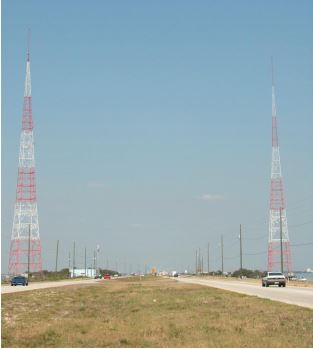
WDAE 620, on the Gandy Causeway
The WFLA calls continue over on 970 kHz, with the power now increased to 25,000 Watts day/11,000 Watts night, into five towers of a six tower array shared with WHNZ (the current occupant of 1250 kHz).
The Search
Ron Rackley, the consulting engineer for the stations, has long had an interest in the history of the WFLA-WSUN 620 kHz facility from 1932, specifically because it was first directional antenna in the world used for AM broadcasting.
Although he knew the original location of the station was at the end of the Courtney Campbell Causeway, the exact location was not readily apparent. Rackley, and Wilson Welch, then the Gulf Coast Director of Engineering for Clear Channel Radio, wondered if any of the original site remained. They sought any information available as to the exact location, and hunted for clues.
Finally, someone discovered an old picture of the site near the causeway.
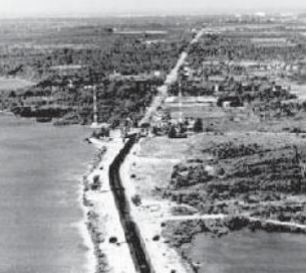
Looking West along the Davis Causeway
A sewage plant now stands on the site of the south tower.
Using the photo as a guide, Welch finally discovered the right location, next to a gas station and convenience store
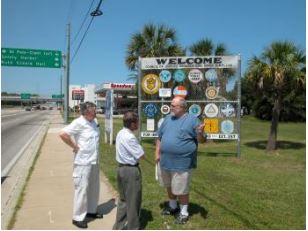
At the edge of the field on the road’s North side
After exploring the area, the original base for the north tower of WFLA-WSUN was found, still in place, hidden in a clump of trees on the back side of a field.
At the time, a new drive-through coffee shop was said to be coming to the site. However, the property is still undeveloped as of the time of writing.
About a hundred feet back from the road, in a clump of trees, there it was, as it had been for decades.
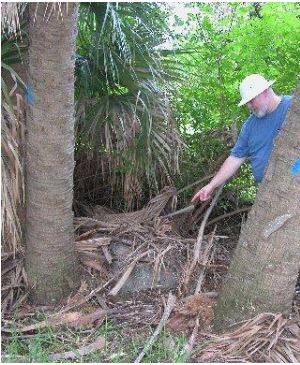
Ron Rackley goes exploring and finds the base of the North Tower of WFLA-WSUN!
Even better, after brushing away some of the vegetation, the date of “Mar 8 ’32,” when the tower bases were poured, was clearly visible!
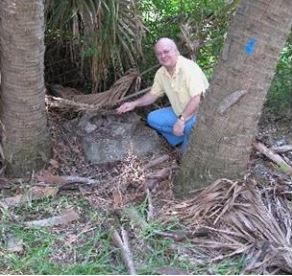
Brushing away the years
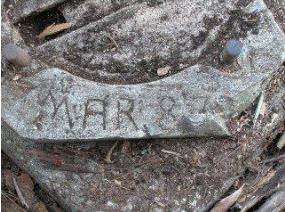
The date reads “MAR 8 ‘32”
Other parts of the installation were also visible, including the guy anchors for the original tower.
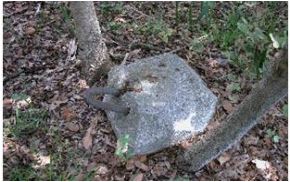
The East Guy Anchor from the North Tower
Here is a close-up of a 1930’s guy anchor.
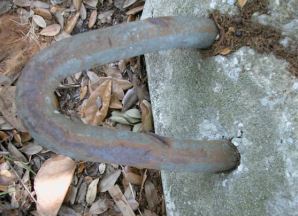
As you can imagine, Rackley and Welch, along with others, would love to see an historical marker placed on this site, to commemorate the start of this first of all directional antennas, and the men who conceived and built it.
Unfortunately, up to this time, the owner of the property has not shown any interest in having this done, but hope continues that some arrangements might be made at some point in the future.
So, now that you know the whole story behind this site and the stations that were here, perhaps the next time you drive past a directional antenna site, whether it be two towers or twelve, you might just stop to pause for a moment and remember Ray Wilmotte and his pioneering designs that made it all possible.
– – –
I would like to offer thanks to Ron Rackley of du Treil, Lundin & Rackley, Wilson Welch, and Vincent Luisi, Director of the Dunedin Historical Society and for their kindness in sharing their time and information in search of the history of the WFLA and WSUN.
